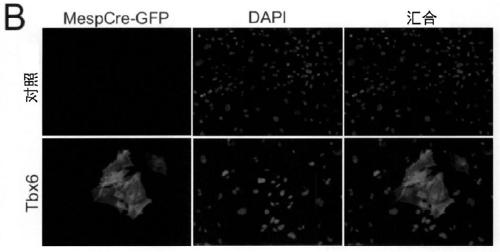Method for directly producing cardiac precursor cell or myocardial cell from fibroblast
A technology of fibroblasts and cardiac progenitor cells, applied in the field of cardiac progenitor cells and cardiomyocytes, can solve the problems of only producing functional, immature cardiomyocyte-like cells, and unable to maintain the state of cardiac progenitor cells
- Summary
- Abstract
- Description
- Claims
- Application Information
AI Technical Summary
Problems solved by technology
Method used
Image
Examples
Embodiment 1
[0147] [Example 1] Production of mouse fetal fibroblasts (MEFs)
[0148] (1) Production of mouse fetal fibroblasts (MEFs)
[0149] Female ICR mice (CLEA Japan, Inc.) from 7 to 10 weeks after birth were compared with Mesp1-GFP transgenic mice (male) (Development 126, 3437-3447 (1999), "MesP1 is expressed in the heartprecursor cells and required for the formation of a single heart tube") to mate. The day when fertilization was confirmed was regarded as day 0 of pregnancy, and fetuses were removed from pregnant ICR mice on day 12 after pregnancy was confirmed. The heart was removed from the fetus, and the heart was projected using fluorescence with an inverted microscope (Olympus Corporation, IX71), and the fetus emitting GFP fluorescence was selected.
[0150] Limbs and 1 / 2-2 / 3 of the head, lungs, liver, kidneys, intestines and other solid organs were removed from the selected fetuses, and were washed with phosphate buffered saline (PBS: phosphate buffered saline) (-) (WAKO co...
Embodiment 2
[0161] [Example 2] Production of induced cardiac progenitor cells and cell culture
[0162] 3.6×10 6 Inoculate Plat-E packaging (Plat-E packaging) cells at a concentration of 3 cells at 37°C / 5% CO 2 Under the condition of standing (the first day).
[0163] On the second day (day2), 27 µL of FuGENE 6 transfection reagent (Promega, E2691) was mixed in 300 µL of Opti-MEM (Gibco, 31985-070). After standing still for 5 minutes, the retroviral plasmid of pMx-Tbx6 (refer to Cell 142, 375-386, August 6, 2010, "Direct Reprogramming of Fibroblasts into Functional Cardiomyocytes by Defined Factors") was injected into the above mixture in an amount of 9000ng. Hit vigorously, then let sit at room temperature for 15 minutes. Add the above solution dropwise to the Plat-E cells prepared on the previous day (the first day), at 37°C / 5%CO 2 Conditioned static (transfection).
[0164] After 24 hours (the third day), the culture medium was replaced with Plat-E medium (DMEM / 10%FBS / PSA) (Table ...
Embodiment 3
[0175] [Example 3] Production and cell culture of induced cardiomyocytes by Tbx6, SRF, and Myocd
[0176] (1) Gene introduction method of Tbx6, SRF, and Myocd by retrovirus
[0177] A virus solution was prepared in the same manner as in "Preparation of Induced Cardiac Progenitor Cells" in Example 2. Among them, three genes were introduced in this example. On the first day, Plat-E cells were prepared in three 10 cm tissue culture dishes by the same method as in Example 2. On the next day, 27 μL of FuGENE 6 transfection reagent (Promega, E2691) was mixed in 300 μL of Opti-MEM (Gibco, 31985-070). After standing still for 5 minutes, pMx-Tbx6, pMx-SRF and pMx-Myocd (manufacturing method refer to Cell 142, 375-386, August 6, 2010, "Direct Reprogramming of Fibroblasts into Functional Cardiomyocytes by DefinedFactors") were injected into the above mixture respectively. 9000ng of retroviral plasmid was knocked vigorously, and then left at room temperature for 15 minutes. Add the ab...
PUM
 Login to View More
Login to View More Abstract
Description
Claims
Application Information
 Login to View More
Login to View More - R&D
- Intellectual Property
- Life Sciences
- Materials
- Tech Scout
- Unparalleled Data Quality
- Higher Quality Content
- 60% Fewer Hallucinations
Browse by: Latest US Patents, China's latest patents, Technical Efficacy Thesaurus, Application Domain, Technology Topic, Popular Technical Reports.
© 2025 PatSnap. All rights reserved.Legal|Privacy policy|Modern Slavery Act Transparency Statement|Sitemap|About US| Contact US: help@patsnap.com



